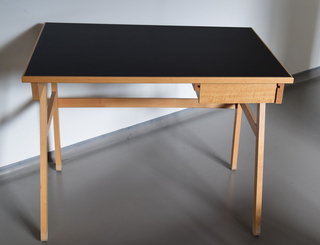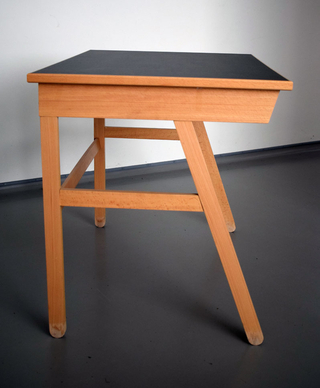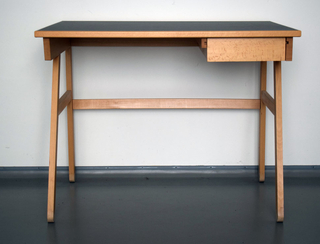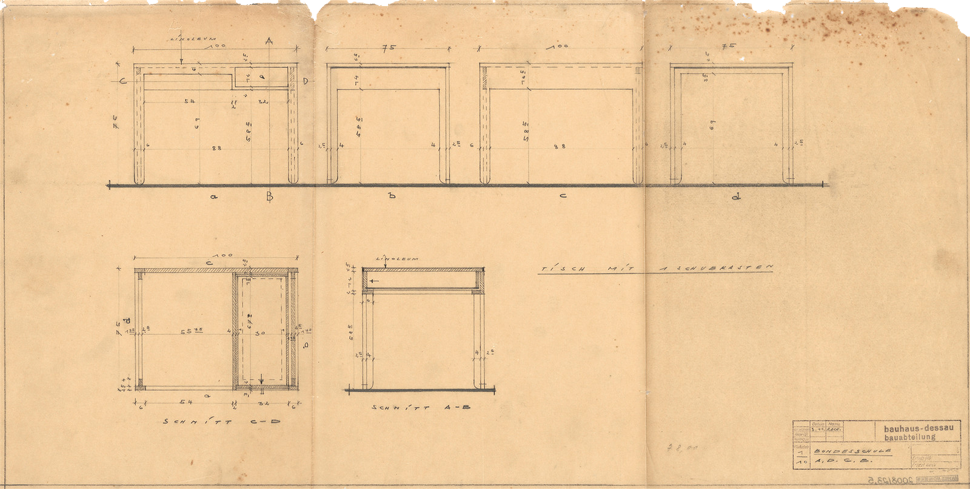With her preliminary-course training in the carpentry workshop at the Bauhaus, Wera Meyer-Waldeck knew how to approach her craft, moving methodically from the needs of eventual users to the materials, to the aesthetic, functional end product. This called for clear formal lines and relatively inexpensive materials that were nevertheless durable and pleasing to the touch. Ease of use was an absolute necessity. These requirements are realized to near perfection in the writing desk designed for the dormitory rooms of the Trade Union School.
The desk that was ultimately produced can be traced to an earlier design by Wera Meyer-Waldeck and Josef Pohl as well as a surviving design sketch. This predecessor is still preserved in the collection of the Bauhaus Dessau Foundation today and can be admired presently in the new Bauhaus Museum exhibition: a dark-hued, fold-away wooden desk with cross braces and slightly sloping legs. By contrast, the first design for the Trade Union School desk already featured the rounded feet characteristic of the final design, but in this case with straight legs. Requests for design improvements based on actual furniture practice were specifically included in the call for bids sent out to furniture manufacturers—the Bauhaus would likely not have had the capacity to produce 120 desks for the student dormitory rooms within a short period of time. The sloping legs and additional cross bracing for stabilizing the desk’s construction are more likely to be attributed to Wera Meyer-Waldeck’s collaboration with Josef Pohl. This desk was presumably her journeyman’s piece for the Bauhaus capentry workshop final exam (a desk is listed in the Bauhaus diploma as a journeyman’s piece, without providing further details).

Anja Guttenberger (photo), Desk from the dormitory rooms of the Trade Union School, reproduction after Wera Meyer-Waldeck, 2018, © baudenkmal bundesschule bernau e. V.
The final product looked like this:
The light-hued, copper beechwood desk, with a black linoleum work surface, is elegant and airy—matching the light-flooded rooms—but also robust, able to withstand the ebbs and flows of course participants for as long as possible. Two single desks, 75 cm high, 65 cm deep and 95 cm wide, were positioned back to back in order to best utilize the ample area of light before the enormous dormitory-room windows and to allow working by daylight. The sloping, front legs of the desk created legroom both in front and on the sides. Rounded leg ends prevented the desk from severely scratching the gray Walton linoleum flooring. Narrow panels on the sides and back established a visual correspondence between the tabletop and the drawer on the righthand side of the desk.
The chair that was originally used with the desk is not a Bauhaus product: the Lehnstockerl (a German word combining Lehnstuhl [backrest] and Hocker [stool]) was designed by the Thonet Brothers, a furniture manufacturing company the Bauhaus had successfully partnered with for years in producing and selling the tubular steel furniture designed by Marcel Breuer. Visually it complemented the simplicity and functionality of the Meyer-Waldeck desk. It is not surprising that Meyer-Waldeck decided to combine it with a proven chair—the Bauhaus only designed something new if there were no other compelling alternatives on the market.
The Bauhaus, and in particular Bauhaus furniture design under Hannes Meyer, is celebrated for its efficiency and functionality. This is evidenced in Meyer-Waldeck’s pragmatic decision to produce the dormitory room desk at the same time in several variations for the Trade Union School, adapting it to the particular space and usage: for the reading room, work surfaces were narrowed (60 cm) and the width enlarged from 1 to 2.40 meters to accommodate a total of four students seated next to one another at the same time. Additional desk legs were added to the center of this large-size version for stabilization purposes. Here, too, Meyer-Waldeck decided to combine it with a proven chair: a Rockhausen swivel chair (model K 32, mahogany). Drawers were avoided altogether in the reading room because they simply served no function there. Another variation on the desk was produced for the lecture rooms: this version featured a wider desktop (140 cm) with a depth of 70 cm. Two drawers were mounted on opposite sides, for two people per table. This variant was also combined with the same Rockhausen swivel chair as in the reading room, only here in a highly polished version.
The Trade Union School desk is just one of many furniture pieces created under the Bauhaus directorship of Hannes Meyer. Meyer, however, seemingly regarded it as a preeminent example of Bauhaus furniture design given how it was centrally featured in the Bauhaus’s Volkswohnung exhibition for the opening of the Leipzig Grassi Museum and also because it played an essential role in presenting the Trade Union School during the Bauhaus Traveling Exhibition.
No original versions of these desks exist today—as far as is known. After the Trade Union School was occupied by the NSDAP in May 1933, and at the very least during a brief period of vacancy following the end of the Second World War, what had not already been replaced was looted, burned for heating, or sold under the table. To date, none of these furniture pieces have appeared on the antiques market. At the Trade Union School association, however, there is a replica of the desk from the Wriezen Interregional Vocational Training Center (ÜAZ) as well as two original Thonet chairs from the same series as those used in the dormitory rooms of the Federal School around 1930—a small consolation that brings to life and clarifies for audiences Wera Meyer-Waldeck’s ingenious and functional desk design.



